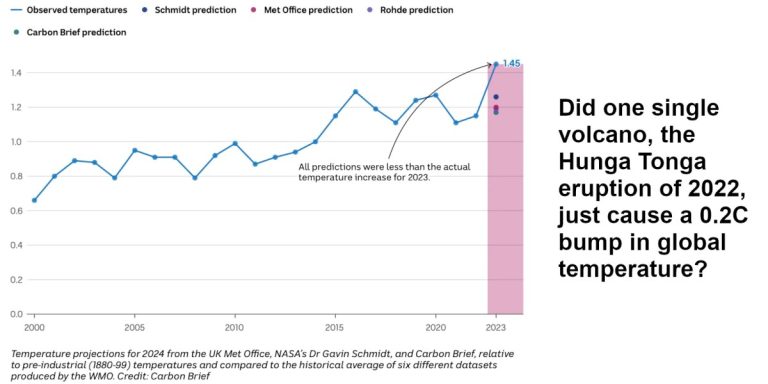Article by Eric Worrell
Some scientists are unable to explain the temperature increase in 2024, which is 0.2 degrees Celsius higher than model predictions.
Study shows that fewer low-altitude clouds may be responsible for the “missing” 0.2 degrees Celsius of warming in Earth's hottest years
Author: Environmental journalist Peter de Kruijff
Friday, December 6
in short:
Lower-than-expected low-level clouds are thought to be a potential cause behind mysterious global warming in 2023.
Last year was the hottest on record, with warming reaching 1.45 degrees Celsius since pre-industrial times, well above climate forecasts of 1.25 degrees Celsius for 2023.
What to do next?
More research is needed to understand the reasons for the decrease in cloud cover and whether the decrease in cloud cover is related to global warming.
A new study suggests that a decrease in the number of low-altitude clouds, caused by unexplained warming, contributed to the world's hottest year on record.
The record-breaking heat of 2023 surprised many climate scientists by raising Earth's surface temperature by an average of 1.45 degrees Celsius above pre-industrial levels.
They simulated the effects of anthropogenic warming and other known drivers to produce their closest prediction, which was about 0.2 degrees cooler than observed temperatures.
…
Gavin Schmidt, a climatologist and director of NASA's Goddard Institute for Space Studies who was not involved in the study, said the study “goes some way to explaining the recent warming process.” .
“But we still can't explain why the albedo changes so much, so there's more work to do before we can say what it means.”
…
Learn more: https://www.abc.net.au/news/science/2024-12-06/clouds-climate-change-warming-planetary-albedo/104680446
Research cited in the above article;
Record-low planetary albedo fuels recent global temperature spike
Helge F. Gosling, Thomas Lacow, and Thomas Jung
December 5, 2024
DOI: 10.1126/science.adq7280abstract
In 2023, the global average temperature will soar by nearly 1.5K compared with pre-industrial levels, which is about 0.17K higher than the previous record. Previous best guesses at known drivers, including anthropogenic warming and El Niño, were about 0.2K worse at explaining the temperature rise. Using satellite and reanalysis data, we identify record low planetary albedo as the main factor closing this gap. This decline is apparently caused primarily by reduced low cloud cover in northern midlatitudes and the tropics, a continuation of a multi-year trend. Further exploring low cloud trends and understanding how much of this is due to internal changes, lower aerosol concentrations, or possible low cloud feedback will be critical for assessing current and expected future warming.
Learn more: https://www.science.org/doi/10.1126/science.adq7280
There's a fairly obvious possible explanation for this year's unusual weather anomalies. Note that I first heard this prediction from climate scientist Jennifer Marohasi, but I don't remember if she ever published a paper.
Tonga volcanic eruption increases likelihood of temporary surface temperature anomalies exceeding 1.5 °C
Release date: January 12, 2023
Stewart Jenkins, Chris Smith, Miles Allen and Roy Granger
On January 15, 2022, the Hunga Tonga-Hunga Hapai (HTHH) eruption injected 146 MtH2O and 0.42 MtSO2 Enter the stratosphere. This large water vapor perturbation means that HTHH may increase net radiative forcing, which is unusual for large volcanic eruptions, thereby increasing the likelihood that global surface temperature anomalies will temporarily exceed 1.5°C over the next decade. Here, we estimate the radiative response to HTHH eruptions and derive an increased risk of global mean surface temperature anomalies exceeding 1.5 °C soon after the eruption. We show that HTHH has a tangible impact on the likelihood of exceeding 1.5 °C soon (increasing the likelihood of exceeding 1.5 °C in at least one year in the next 5 years by 7%), but the level of ambition of climate policy, especially mitigation measures in the short term The effects of climate pollutants dominate the outlook for temperatures above 1.5°C on decadal timescales.
Learn more: https://www.nature.com/articles/s41558-022-01568-2
Global decline in cloud cover may have nothing to do with Hunga Tonga – It is possible that Hunga Tonga had no impact and that lower cloud cover due to unknown forcing was the culprit. But predictions of rising global temperatures and unusual weather, followed by predictions of rising global temperatures and unusual weather, appear to be an extremely coincidental occurrence.
If Hunga Tonga is the mysterious factor behind the global cloud decline, and if a volcanic eruption can surprise scientists like Gavin Schmidt and cause global temperatures to rise by 0.2 degrees Celsius, then natural forcing serves as a potential contributor to the global cloud decline. Contributor, definitely deserves more attention. At the very least, it's a powerful reminder that there are still big gaps in our understanding of the global climate system.
Another takeaway from the current shock is that wild predictions that global warming of 1.5 degrees Celsius would lead to climate catastrophe have now been proven to be nonsense. If climate scientists hadn't announced a temperature rise of 0.2 degrees Celsius, who among us would have noticed?
Relevant
